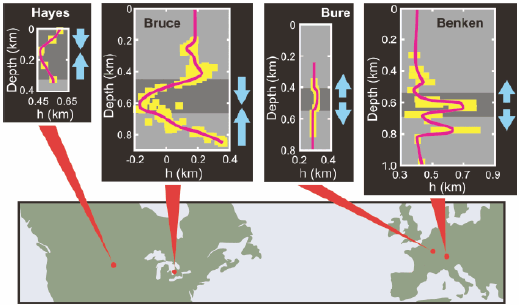Civilian nuclear power plants came on line in the mid-1950s before most of us were born. Yet in all the years since then, there has never been a permanent place to keep their highly radioactive wastes. The resulting technological constipation was supposed to be solved with a repository carved into the volcanic rocks of Yucca Mountain in southern Nevada. As geologists got into the details, the worrisome part of Yucca Mountain turned out to be not rock, but water leakage.
We think of rock as strong, permanent material, and we tend to think the best rock should be the strongest. The U.S. and other nations have sought to keep their wastes in deep, crystalline rocks like granite. But we are misled by the presence of rocky mountains and the impregnable facades of bank buildings. The hardest rock, in geological reality, is highly fractured stuff because with strength comes brittleness. Tests at Yucca Mountain showed that some of the cracks in its volcanic rocks could have allowed rainwater to trickle down to the storage levels in a mere 50 years—this in a facility that by law is supposed to keep things safe not just for 10,000 years, but a million. That was all the scientific evidence needed to reinforce the stiff political opposition to Yucca Mountain, and by the time the Obama administration told Congress in 2009 that the project was off the table, it was all over but the shouting.
Now a government hydrologist, Christopher Neuzil, uses his knowledge of groundwater to make a case instead for shale. The best metric for a waste repository rock is not its strength, he says, but its impermeability—resistance to water. This argument changes the game dramatically.

Shale, for our purposes, is rock that is primarily clay. Because geologists are choosy about what they call shale, Neuzil uses “shale” as shorthand for “argillaceous formations” (mudrocks and claystones). Water has a very difficult time moving through it. A lot of specialists don’t like shale: water-well drillers find it unproductive; geotechnical engineers hate to deal with its poor strength; miners consider it waste rock; road builders must take special care in it. On the other hand, shale is good for municipal landfills and for wetlands precisely because it’s so impermeable. Thick beds of shale are what keeps “fracked” oil and gas separate from drinking-water supplies.
Neuzil’s publically readable paper, “Can Shale Safely Host U.S. Nuclear Waste?” is in this week’s issue of Eos, the house organ of the American Geophysical Union. In it he points out an interesting peculiarity of shale: in many places it has different groundwater pressure than the surrounding rocks. In some places the shale has excess groundwater pressure; in others it’s actually negative—the rock would suck up more water if it could but it’s too impermeable. Imagine a waste repository in a place like that where water moves inward rather than outward.
